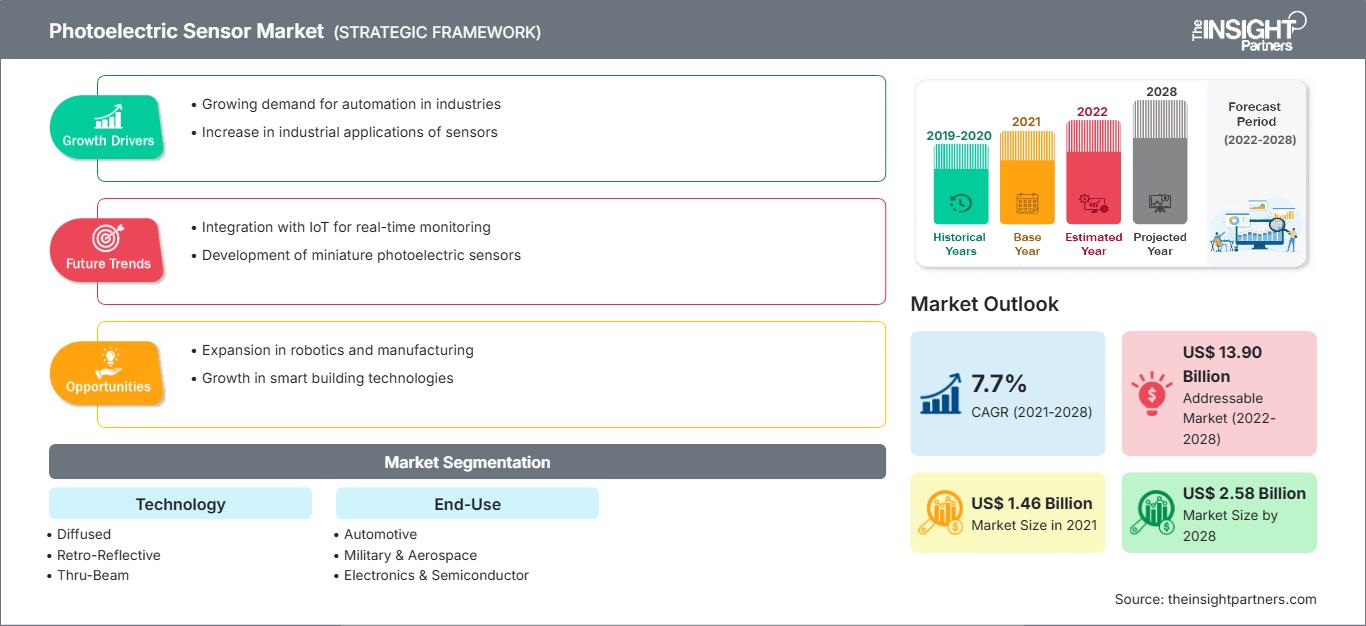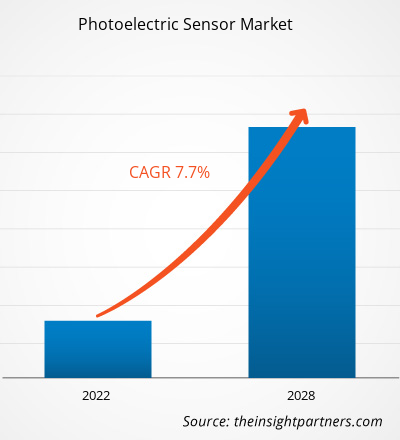[研究报告] 2021年光电传感器市场规模为14.5823亿美元,预计到2028年将达到25.7756亿美元;预计2021年至2028年的复合年增长率为7.7%。
光电传感器因其高可靠性和远距离物体检测能力而日益普及,无论物体的尺寸、形状、颜色、材质和表面特性如何。这些传感器专为在恶劣条件下工作而设计;此外,它们采用先进技术,可确保可靠地抑制不良反射。这些能力使它们比许多其他类型的传感器更加通用,非常适合工业用途。例如,带有偏振滤光片的反射式传感器可以检测任何形状和材质的车厢的位置,使其保持在过山车的轨道上或轨道外。此外,光电传感器凭借其高精度和可靠的性能,广泛应用于军事和航空航天工业。它们用于货机的烟雾和火灾探测。此外,光电传感器还能帮助机身和发动机制造商监测航空航天系统参数,例如压力、温度、加速度、光学位置和速度。此外,国防工业正在广泛使用生物检测设备来检测环境中化学物质的存在,并通过检测有害生物材料来评估潜在生物威胁的风险,以保护军人和平民的安全。因此,光电传感器操作的精确性和可靠性使其成为恶劣工业条件下的首选传感器类型。
COVID-19疫情对光电传感器市场的影响
根据世界卫生组织 (WHO) 的最新报告,美国、西班牙、意大利、法国、德国、英国、俄罗斯、土耳其、巴西、伊朗和中国是受 COVID-19 疫情影响最严重的国家。 2020年,世界经济遭受了重大冲击,预计未来几年这种影响仍将持续一段时间。疫情扰乱了电子、半导体和制造业等主要产业。这些行业增长的急剧下滑限制了光电传感器市场的增长。为抗击和控制疫情而实施的工厂停工、旅行和贸易禁令以及边境封锁,对各种传感器产品的制造、供应和销售产生了负面影响。
自定义此报告以满足您的要求
您将免费获得任何报告的定制,包括本报告的部分内容,或国家级分析、Excel 数据包,以及为初创企业和大学提供超值优惠和折扣
光电传感器市场: 战略洞察

- 获取本报告的主要市场趋势。这个免费样本将包括数据分析,从市场趋势到估计和预测。
您将免费获得任何报告的定制,包括本报告的部分内容,或国家级分析、Excel 数据包,以及为初创企业和大学提供超值优惠和折扣
光电传感器市场: 战略洞察

- 获取本报告的主要市场趋势。这个免费样本将包括数据分析,从市场趋势到估计和预测。
光电传感器制造商正致力于降低运营成本以保持竞争力。不过,预计他们将在解封后恢复生产活动。政府的刺激经济举措和解封措施的放松预计将在预测期内刺激对光电传感器的需求。随着新技术在汽车和航空航天工业中的应用越来越广泛,对光电传感器的需求可能会扩大。
光电传感器市场洞察:制药行业对光电传感器的需求不断增长推动了光电传感器市场的增长
制药公司专注于通过避免诸如空包装之类的差异来改善其整体制造运营,空包装可能是由于生产线上药片不可用而造成的。该行业越来越多地部署光电传感器用于药片计数、瓶子灌装和计数验证(在临床试验中)。这些传感器也用于零售药店和医院的自动处方机。此外,光电传感器在传感范围方面的进步提高了计数精度,同时通过在药品包装过程中避免人为接触来保持卫生的生产环境,这些都是光电传感器的优势。此外,光电传感器还提供了一种经济高效的解决方案,这在制药行业的自动化生产线中得到了应用。因此,光电传感器在制药公司中的应用激增,主要归因于其能够提高效率、降低行业运营成本并促进实时生产监控。这些传感器可以自动测量罐或槽中液体的上下液位。在制药公司中,使用强腐蚀性化学品(酸性或碱性)的情况很常见,因此,检测储罐中的液位是这些工厂的一项重要任务。因此,光电传感器在制药行业的日益普及将推动未来几年光电传感器市场的增长。
基于技术的市场洞察
根据技术,光电传感器市场细分为漫射型、反射型和对射型。2020 年,反射型市场占据了最大的市场份额。
基于最终用户的市场洞察
根据最终用户,光电传感器市场细分为汽车、军事和航空航天、电子和半导体、封装等。2020 年,汽车领域占据了最大的市场份额。
光电传感器市场的参与者采用合并、收购和市场举措等策略来保持其在市场中的地位。以下列出了一些主要参与者的发展:
- 2020 年 4 月,巴鲁夫光电传感器提供了状态监测数据。智能自动化和监控系统 (SAMS) 产品组合包括固体光电传感、状态监控和先进的 IO-link 技术,所有这些技术都旨在通过简化故障排除、转换和机器设置来节省停机时间。
- 2020 年 2 月,伊顿公司被《财富》杂志列为 2020 年全球最受赞赏的公司之一。
光电传感器市场区域洞察
The Insight Partners 的分析师已详尽阐述了预测期内影响光电传感器市场的区域趋势和因素。本节还讨论了北美、欧洲、亚太地区、中东和非洲以及南美和中美洲的光电传感器市场细分和地域分布。
光电传感器市场报告范围
| 报告属性 | 细节 |
|---|---|
| 市场规模 2021 | US$ 1.46 Billion |
| 市场规模 2028 | US$ 2.58 Billion |
| 全球复合年增长率 (2021 - 2028) | 7.7% |
| 历史数据 | 2019-2020 |
| 预测期 | 2022-2028 |
| 涵盖的领域 |
By 技术
|
| 覆盖地区和国家 | 北美
|
| 市场领导者和主要公司简介 |
|
光电传感器市场参与者密度:了解其对业务动态的影响
光电传感器市场正在快速增长,这得益于终端用户需求的不断增长,而这些需求的驱动因素包括消费者偏好的演变、技术进步以及对产品优势的认知度的提升。随着需求的增长,企业正在扩展产品线,不断创新以满足消费者需求,并抓住新兴趋势,从而进一步推动市场增长。

- 获取 光电传感器市场 主要参与者概述
- 漫射
- 反射式
- 对射式
按最终用户
- 汽车
- 军事和航空航天
- 电子和半导体
- 封装
- 其他
按地域
- 北美
- 美国
- 加拿大
- 墨西哥
- 欧洲
- 法国
- 德国
- 意大利
- 英国
- 俄罗斯
- 欧洲其他地区
- 亚太地区 (APAC)
- 中国
- 印度
- 南韩国
- 日本
- 澳大利亚
- 亚太地区其他地区
- 中东和非洲 (MEA)
- 南非
- 沙特阿拉伯
- 阿联酋
- MEA 其他地区
- 南美洲 (SAM)
- 巴西
- 阿根廷
- 南美洲其他地区
公司简介
- Autonics Corporation
- Balluff GmbH
- Eaton Corporation plc
- Ifm Electronic GmbH
- Keyence Corporation
- OMRON Corporation
- Rockwell Automation, Inc.
- Panasonic Corporation
- SICK AG
- Schneider Electric SE
- 历史分析(2 年)、基准年、预测(7 年)及复合年增长率
- PEST和SWOT分析
- 市场规模、价值/数量 - 全球、区域、国家
- 行业和竞争格局
- Excel 数据集
近期报告
相关报告
客户评价
购买理由
- 明智的决策
- 了解市场动态
- 竞争分析
- 客户洞察
- 市场预测
- 风险规避
- 战略规划
- 投资论证
- 识别新兴市场
- 优化营销策略
- 提升运营效率
- 顺应监管趋势






















 获取免费样品 - 光电传感器市场
获取免费样品 - 光电传感器市场